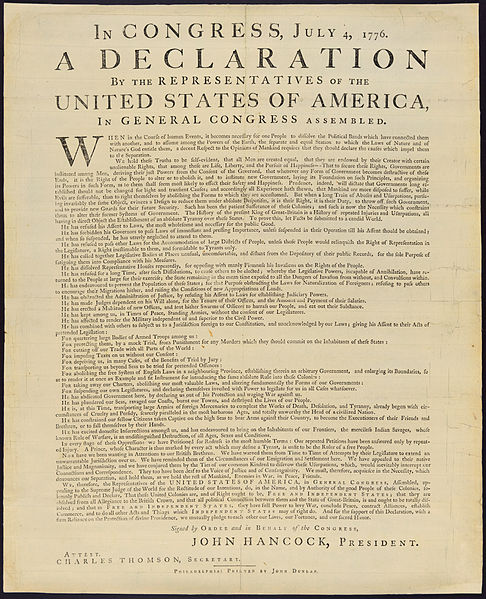Dunlap, The Declaration of Independence, 1776
On this date in 1776, the Declaration of Independence was read aloud to Gen. George Washington's troops in New York.
The Dunlap Broadsides are called that because they were printed by John Dunlap, a Philadelphia printer who eventually became the the official printer to Congress in 1778. Over the night of July 4/5, 1776, Dunlap printed possibly one of the most important documents of his career with these first editions of the Declaration of Independence. In doing so, he produced the first public and published version of the Declaration.
The exact number Dunlap printed is unknown, but is estimated to be around 200—enough to comply with Congress’s orders that the copies be distributed among the new states and troops, read aloud, and posted in public areas.
Congress kept its own copy, which was inserted into the Journal of the Continental Congress’s July 4 entry, and George Washington had his own personal copy as well. His troops heard the Declaration read aloud on July 9 in New York City. That evening the local Sons of Liberty chapter gathered to pull down and destroy an impressive bronze statue of King George III on the southern end of Broadway, in an iconic moment of the Revolution.
CONNECT
The Library of Congress allows a close examination HERE.
The incredible FONTS IN USE explains the issues involved in quickly printing and distributing the Declaration of Independence in 1776 ... HERE.
On this date in 1776, the Declaration of Independence was read aloud to Gen. George Washington's troops in New York.
The Dunlap Broadsides are called that because they were printed by John Dunlap, a Philadelphia printer who eventually became the the official printer to Congress in 1778. Over the night of July 4/5, 1776, Dunlap printed possibly one of the most important documents of his career with these first editions of the Declaration of Independence. In doing so, he produced the first public and published version of the Declaration.
The exact number Dunlap printed is unknown, but is estimated to be around 200—enough to comply with Congress’s orders that the copies be distributed among the new states and troops, read aloud, and posted in public areas.
Congress kept its own copy, which was inserted into the Journal of the Continental Congress’s July 4 entry, and George Washington had his own personal copy as well. His troops heard the Declaration read aloud on July 9 in New York City. That evening the local Sons of Liberty chapter gathered to pull down and destroy an impressive bronze statue of King George III on the southern end of Broadway, in an iconic moment of the Revolution.
CONNECT
The Library of Congress allows a close examination HERE.
The incredible FONTS IN USE explains the issues involved in quickly printing and distributing the Declaration of Independence in 1776 ... HERE.









































































































































































No comments:
Post a Comment